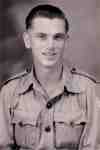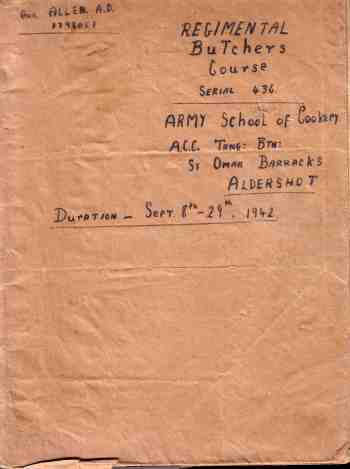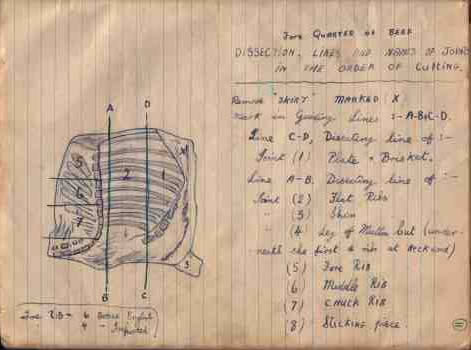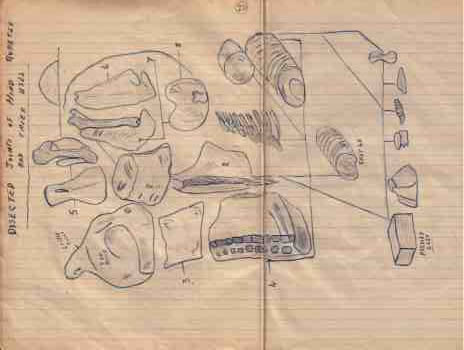
home | 1900 | 1925 | 1930 | 1937 | 1941 | 1945 | 1946 | 1949 | 1952 | 1956 | 1960 | 1969 | 1978 | greenwich | info
< click to enlarge - Alf in Madras in February 1944.
From enlistment -24th April 1941 - through basic training & anti-aircraft service in the Midlands, to Army Butchery courses & how to convince each AA Gun-Site they were getting meat...
I think I must have fancied myself in "Air Force Blue" uniform, because when I registered for National Service I said I preferred the RAF. Sometime in 1940 (I think) I was sent to the Territorial Army Barracks at Stonecot Hill, North Cheam to have my medical examination and interview for the RAF. It was a very strict medical and I believe I had my eyes tested about nine times. I passed the medical examination grade A1, but then had to have an interview with the RAF recruiting officer. I was with him for less than two minutes; he only wanted to ask me one question... "Was I prepared to learn to fly?"
My answer to that was "NO!" but I was keen to train as a RAF butcher or some other catering job. He said there were no vacancies for those jobs, only for pilots. He told me to wait outside; I was then passed on to the army recruiting officer. He seemed a lot more amiable and said I should be able to get a butchery or catering job in the army and made a note about it; he also asked me questions about my father's army service in the last war but I wasn't able to tell him much.
So, I wasn't really surprised when, a few months later, I received my call-up papers and found I would be going into the Royal Artillery. I was to report to the RA training regiment at Newquay in Cornwall. I was aged nineteen, this was to be my first time away from home apart from being in hospital as a child and it was a strange experience.
My enlistment date was 24th April 1941. The journey to Cornwall was quite eventful: it started at Paddington Station in London where my family saw me off on the train; I found myself in a compartment with other lads going to the same place as myself. At some point in the seemingly endless journey to Cornwall our carriage was disconnected from the rest of the train and we found ourselves in a siding just outside Plymouth and had to wait for another engine to pick us up. After hours of shunting around we eventually arrived at Newquay station to be met by a rather irate sergeant who piled us all on to a three-ton lorry to take us to an hotel which was to be our "barracks" for the next three months.
It was my first visit to Cornwall, not that we had much time for sight-seeing, but our training programme did take us to some of the coastal beauty spots. I can't remember the names of all the places we visited in the course of our training exercises but we saw a lot of the Cornish countryside, mostly from the back of a lorry. One place I shall never forget is St Agnes where the anti-aircraft firing camp was situated; I was to get to know that place quite well as I returned there later in my army service to take gunnery refresher courses.
I spent the first two years of my army service on light anti-aircraft gun sites in England and Wales, mostly in the Midlands and on the South Coast; my first posting to a gun site was at Fort Dunlop in Birmingham. The guns were sited on the flat roof and various parts of the building were used as barracks accommodation. It's difficult to remember all of the places we were stationed as we were on the move quite a lot, but some of the place names come to mind: Leamington Spa, Meriden, Redditch, Bromsgrove, Warwick, Donnington in Salop, Seighton Camp at Chester and in Wales, Prestatyn, Rhyl, New-Quay, Aberaeon, to name just a few.

Whilst still in the Midlands I was sent on a regimental butcher's course at Aldershot. It was at St Omar Barracks, the training centre for the Army Catering Corps and was a twenty-one day course, from 8th September to 29th September 1942.

On completion of the course I was immediately posted to a new AA battery at Stanford-le-Hope in Essex and from there to Canvey Island. As the regimental butcher I was now on the establishment of battery HQ and was answerable to the quartermaster, which meant I got involved in stores duties as well as my own. By now we were moving the HQ from one town to another and serving our gun sites, which were scattered around the surrounding area.
Again I can't remember all the place names, but we were moving around Kent and the East Coast. I remember being near to Margate, Ramsgate and Deal. At Betteshanger Colliery, which was a prime target for enemy attacks, our Bofor guns chased off the low flying Messerschmitts as they came over the Channel.
Our gun sites were manned by about eight men including one man who would do the cooking and look after stores and rations for his site. He had the unenviable task of trying to stretch out the food supplies to last all day and was the butt of the complaints from his fellow gunners. My job, along with a driver, was to distribute the well-earned rations in a special food container to everyone of the ten or more gun sites which were scattered all over the surrounding countryside, often in well-hidden corners of a muddy field. We would carry the rations in the metal food container, plus milk, drinking water and other supplies that were ordered, including mail and even coal.
We would collect the empty container, which had held yesterday's food and was usually still dirty, as well as a load of abuse from the cook about the shortage of food, etc. These deliveries were usually made daily, but sometimes separate deliveries were made with coal or paraffin. A lot of our trips to the gun sites were made at night and certainly not at regular intervals, so the cooks must have found it very difficult to organise the meals, especially as these were active gun sites.
My job as regimental butcher was a very busy one. One of my daily tasks was to scrub out every one of the large metal food boxes, which were used to transport the rations to the gun sites. Each box was painted green and had the site number printed on it (I even painted-on the numbers myself); there were three boxes to each site, one in store, one being packed and one in use on the gun site. Usually the boxes were cleaned out as soon as I got back from the delivery round but sometimes got left until early next morning...

Fresh meat had to be collected daily from the Service Corps Depot, which I believe was near Margate. I had no choice of cuts or type of meat, the total ration was issued to me in bulk usually wrapped in hessian, according to the number of men I had to supply. The ration scale was 6 ounces (170 grams) per man including bone, or 4 ounces boneless per day. It was the same allowance for beef, pork or mutton. My job when I got back to my own store was to cut the meat into joints or suitable sized cuts for each gun site. Often, because of the bone content, there was not sufficient to feed the eight men (or whatever), so each site would have to take it in turn to have a meat-less day and make up for it by having a good ration on the following day. Corned beef was also an option; bacon was supplied four times a week for breakfast; sausages twice a week and 4 ounces of offal once a week. Cooking fat was rationed at 2 ounces per man per week. All this had to be worked out daily along with other rations such as vegetables, potatoes, bread, butter, eggs, sugar, tea and such requirements. Each site-box was packed and sealed, then loaded on to the truck for delivery to the sites.
When my unit had completed its term of duty in Kent, we were split up and posted to various training units for refresher gunnery training in preparation for overseas posting. I was in camps near Camberley in Surrey and at Bracknell in Berkshire, certainly within easy travelling distance from home for weekend leave. Apart from gunnery training, I got involved in painting tactical signs on some of the new army vehicles which had been allocated to the unit.
I think it was while I was at Camberley that I met Charlie Smirke, the well-known jockey. I had only been in the camp for a few hours and was busy painting my name on my new tea mug after meeting some of the other gunners sharing my barrack hut. I soon found myself painting names and symbols for some of the other lads in the hut, then someone said- "I hope you can draw a horse & jockey because Charlie Smirke will want one on his mug too - he sleeps in this hut!" They were all surprised when I had to admit that I'd never heard of him. Later on that day I did meet him, it turned out that he WAS the famous jockey and was doing his National Service the same as the rest of us. Gunner C Smirk was just "one of the lads", his job on the camp was as petrol truck driver and I got to know him quite well during the time I was at the camp. It transpired that I had probably delivered meat to his house before we were called-up, because he lived at Ewell, which was on our delivery round, but I had never heard of him.
The final part of our training was to take place at the Royal Artillery Anti-Aircraft Depot at Shrapnel Barracks at Woolwich, where we were assessed for potential leadership, amongst other things. Here we were kitted-out with tropical kit and on a given day marched from our barracks to Woolwich Railway Station, still totally unaware of our destination and boarded a train, which was to take us to Liverpool. The train, I seem to remember, took us direct to the dockyard platform where we were joined by hundreds of other troops who were awaiting their turn to be ushered aboard the giant ocean liners which had been converted into troop ships.
I can't remember our dates of departure from either Woolwich or Liverpool but it must have been early 1943. Our ship was the Athlone Castle. We were about three days at sea when it was announced that we were bound for India.
Continues on page two

This work is licensed under a Creative Commons Attribution-Noncommercial-No Derivative Works 2.0 UK: England & Wales License.
Text by Alf Allen 1999. Edited and spell-checked by Mike Allen 2003.
Most photos taken by Alf and most illustrations drawn by him; scanned from
his albums, etc., now in my possession and digitally edited 2003-2005.
Yes, yes, the photos and layout need updating - the website was first designed in "dial-up days", before any sort of broadband, and everything had to be small so it uploaded and downloaded fast. Work to do, I know.
Website produced 2003-2013 by Mike Allen - a fatuous platitudes production.
Last changed 28-Aug-2013 22:54